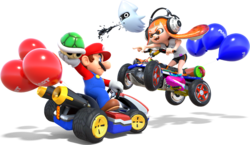Battle
- This article is about the mode in the Mario Kart series. For the musical theme from Mario Kart 64 also known as simply "Battle", see Battle Arenas (theme). For the type of minigame in the Mario Party series, see Minigame § Battle minigames.
- "Battle Mode" redirects here. For other uses, see Battle Mode (disambiguation).
Battle (also known as Battle Mode) is a collection of game modes featured in the Mario Kart series. Instead of races, Battles centers drivers battling each other under various rulesets, usually around battle courses, which are enclosed arenas that are smaller than normal racetracks. Battle modes include Balloon Battle, in which drivers fight to pop each other's balloons and Coin Runners, in which drivers compete to collect the most coins, among others.
Originally, in the first four games, Battle mode is only available in multiplayer. Starting in Mario Kart DS, it can also be played in single player and in teams. In Mario Kart Wii, the team mode was changed to remove teammate friendly fire, though this would be reimplemented in later games. The pool of items that can be used in Battles is usually different from other modes, with items such as the Bullet Bill, Chain Chomp, Crazy Eight, and Spiny Shell not appearing. On the other hand, the Feather in Mario Kart 8 Deluxe and Mario Kart Tour is exclusive to Battles. In all games, the engine class of Battles is fixed to 50cc. An exception is the Renegade Roundup mode from Mario Kart 8 Deluxe where it is increased to 100cc.
Though a staple for the series, Battle mode is absent from the Mario Kart Arcade GP series and Mario Kart Live: Home Circuit.
Modes[edit]
| Name | Description | Games |
|---|---|---|
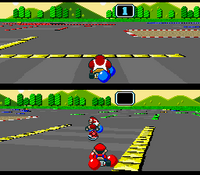 Balloon Battle |
Balloon Battle debuted in Super Mario Kart and has appeared in all console installments since then. In this mode, drivers must use items to hit the opposing player to pop or steal one of their balloons, usually three in total (five in Mario Kart DS, Mario Kart 8 Deluxe and Mario Kart World). If all balloons are popped, the driver is out. Victory is determined by the driver, or team, who popped the most balloons, although prior to Mario Kart Wii, the last driver remaining is determined the victor. | Super Mario Kart Mario Kart 64 Mario Kart: Super Circuit Mario Kart: Double Dash!! Mario Kart DS Mario Kart Wii Mario Kart 7 Mario Kart 8 (Mario Kart 8 Deluxe) Mario Kart Tour Mario Kart World |
 Shine Thief |
Shine Thief first appeared in Mario Kart: Double Dash!! and centers around a large Shine Sprite. Drivers compete to hold on to the Shine Sprite until a timer runs out. Whoever is carrying it when the timer ends is declared the winner. | Mario Kart: Double Dash!! Mario Kart 8 Deluxe |
Bob-omb Blast |
Bob-omb Blast is a battle mode centered around using Bob-ombs to hit other drivers and gain points. The objective is to be the first driver to get a certain amount of points in Mario Kart: Double Dash!!, or be the driver with the most points by the end of a time limit in Mario Kart 8 Deluxe. | Mario Kart: Double Dash!! Mario Kart 8 Deluxe |
Shine Runners |
Shine Runners is a battle mode found only in Mario Kart DS. The objective of the mode is to be the last driver remaining by collecting Shine Sprites spread around the course. Every thirty seconds, (sixty at the start), the drivers with the fewest Shines are eliminated. | Mario Kart DS |
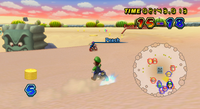 Coin Runners |
Coin Runners (or Coin Battle in the British English version of Mario Kart 7) is a battle mode where drivers must collect the most coins, which spawn continuously scattered across battle courses. The driver or team with the most coins by the end of the time limit is the winner. | Mario Kart Wii Mario Kart 7 Mario Kart 8 Deluxe Mario Kart World |
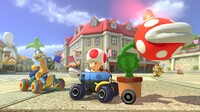 Renegade Roundup |
Renegade Roundup is a battle mode in the vein of "cops and robbers," where a team designated as the Authorities must use Piranha Plants in order to capture the other team, designated the Renegades. The Authorities win if they capture all Renegades, while the Renegades win if at least one of them is free when the timer runs out. | Mario Kart 8 Deluxe |
History[edit]
Super Mario Kart[edit]
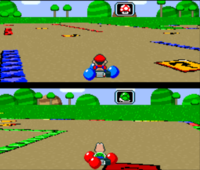
Battle Mode debuted in Super Mario Kart, featuring a single ruleset that would later on become known as Balloon Battle. It is only available with two players, and no computer-controlled drivers.
Mario Kart 64[edit]
Battles return in Mario Kart 64, with similar rules. The number of players that can participate has been increased to four players, although the mode remains multiplayer-exclusive.
Mario Kart: Super Circuit[edit]
Battles also return as the only Battle mode in Mario Kart: Super Circuit, played similarly to its iteration in Mario Kart 64, but with players turning into Bob-ombs instead of Mini Bomb Karts.
Mario Kart: Double Dash!![edit]
In Mario Kart: Double Dash!!, Battles have been expanded to feature three modes: Balloon Battle, which uses the Battle rules from previous Mario Kart games, Shine Thief, where players must hold on to a Shine Sprite for until the time runs out, and Bob-omb Blast, where players can score points by attacking each other with Bob-ombs. The game's LAN Mode allows up to eight players (sixteen with Co-op Play) to play.
Mario Kart DS[edit]
Mario Kart DS includes two Battle modes: Balloon Battle and Shine Runners, where drivers must collect the most Shine Sprites. For the first time, battles can now be played in singleplayer. Unlike Mario Kart: Double Dash!!, drivers can also only use the Standard Kart.
Mario Kart Wii[edit]
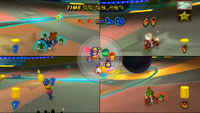
Mario Kart Wii includes two Battle modes: Balloon Battle and Coin Runners, a mode similar to Shine Runners where drivers must instead collect the most coins. Only the Standard Kart and Standard Bike are used in this mode. All battles are now timed to three minutes, and the drivers are divided into two teams, with free-for-all matches not available. Mario Kart Wii's battle courses are unique in that their feature as that they change throughout the battle, either periodically (Thwomp Desert) or at a specific point (Block Plaza, Delfino Pier, and Chain Chomp Wheel). The only course in the game to which this does not apply is Funky Stadium.
Since Mario Kart Wii, Battle mode has a different countdown sound at the start; instead of the regular beeps heard in normal races, they are replaced by air horns, with the only exceptions being Mario Kart Tour and Mario Kart World.
Mario Kart 7[edit]
Mario Kart 7 features the same Battle modes as Mario Kart Wii: Balloon Battle and Coin Runners. These modes are not grouped together under a single "Battle" mode. The battle modes now allows players to play in two teams or in a free-for-all match, and the time limit of the match is reduced to two minutes. In addition, any vehicle can now be used in them, like in Mario Kart: Double Dash!!.
Mario Kart 8[edit]
Mario Kart 8 features Balloon Battle as its only Battle mode for the first time since Mario Kart: Super Circuit. Thus, the mode is known simply as Battles. Unlike previous games in the series, Battles only take place on regular race courses throughout the game. As a result of changes to the mode, the Battle mode in Mario Kart 8 has been criticized for the lack of original battle stages.[1]
Mario Kart 8 Deluxe[edit]
In contrast to Mario Kart 8, Mario Kart 8 Deluxe includes five Battle modes, the most in the series so far. The modes included are Balloon Battle, Coin Runners, Shine Thief and Bob-omb Blast returning from previous games, and Renegade Roundup, a new asymmetrical Battle mode where one team must capture the opposing team. Mario Kart 8 Deluxe also features battle courses instead of regular race courses used for Battle modes.
Mario Kart Tour[edit]
Balloon Battle returns as the only Battle mode in Mario Kart Tour. It was added in the Battle Tour, in October 2022, where alongside being available as a multiplayer mode, battle courses can also be found as part of cups. All battle courses, which include variations of city courses such as New York Minute, use SNES Battle Course 1's music from Mario Kart 8 Deluxe instead of their original music tracks or renditions thereof.
Mario Kart World[edit]
Mario Kart World features two Battle modes: Balloon Battle and Coin Runners.
Gallery[edit]
- For this subject's image gallery, see Gallery:Battle.
Artwork of Battle Mode in Super Mario Kart
Screenshot of Shine Thief in Mario Kart: Double Dash!!
Screenshot of Battle Mode in Mario Kart 8
Screenshot of Bob-omb Blast in Mario Kart 8 Deluxe
Names in other languages[edit]
This section is a stub. Please consider expanding it to include any missing information. Specifics: Names for just "Battle"
Battle Mode[edit]
| Language | Name | Meaning | Notes |
|---|---|---|---|
| Japanese | バトルモード[?] Batoru Mōdo |
Battle Mode | |
| Chinese (Simplified) | 对战模式[?] Duìzhàn Móshì |
Battle Mode | |
| Chinese (Traditional) | 對戰模式[?] Duìzhàn Móshì |
Battle Mode | |
| Dutch | Gevechtsstand[?] | Battle Mode | |
| French | Mode bataille[?] | Battle Mode | |
| German | Kampfmodus[?] | Battle Mode | |
| Italian | Modalità battaglia[?] | Battle Mode | |
| Korean | 배틀 모드[?] Baeteul Modeu |
Battle Mode | |
| Portuguese | Modo Batalha[?] | Battle Mode | |
| Russian | Режим «Бой»[?] Rezhim "Boy" |
Battle Mode | |
| Spanish | Modo batalla[?] | Battle Mode |
References[edit]
- ^ Mc Shea, Tom (May 15, 2014). Mario Kart 8 Review. GameSpot. Retrieved May 22, 2017. (Archived June 24, 2014, 18:15:47 UTC via Wayback Machine.)
